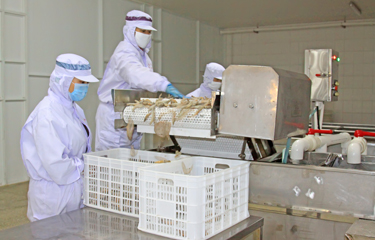Despite the coronavirus pandemic that has hurt China’s domestic seafood market, there are signs of confidence in the country’s seafood processing and trading sector.
One of China’s leading conglomerates is hiring again – the Shandong Ocean Group Co has advertised in local media for a range of managerial and R&D positions at its subsidiary companies in the province. The state-owned firm has a processing arm and is also seeking to grow its business in producing fry for premium aquaculture operations, including grouper farms. The company has stepped up recruitment of scientific managers for its fry base in Yantai.
Also hiring is the firm behind a new processing plant described as the most automated in eastern China. Jiangsu Zhengyuan Chuang Hai Agriculture Science & Technology Co. is hiring for a range of roles at the domestic-market-focused plant, offering an average salary of CNY 6,000 (USD 840, EUR 720) per month for factory floor roles. The new plant will process crustaceans from nearby aquaculture farms in one of the hubs of crab and crayfish production in China.
Founded in 2016, the firm behind the new plant is owned by a Shanghai-based investment company, which has put CNY 350 million (USD 49 million, EUR 42 million) into the plant and a number of crab and crayfish farms surrounding the plant. The complex also includes a feed mill capable of producing 50,000 tons of feed per year and a cold storage warehouse with a 2,000-ton capacity, as well as an R&D center, an e-commerce facility, and a “fish culture” venue for visitors.
Numerous big-ticket fishery projects are getting greenlighted in China as the country turns to the old reliable fallback of investment as a means of stimulating the country’s struggling economy. Large trading and processing centers are currently in fashion among Communist Party cadres who run the big coastal cities (and compete against each other for investment and kudos from the national government apparatus), which could in turn have major consequences for stocks in international waters, which are frequently targeted for extraction by the new complexes.
Among the new seafood processing projects to break ground recently is the first phase of a “seafood park” being built by a state conglomerate with deep pockets in the northerly city of Daqing. An 80,000-square-meter seafood trading center under construction is part of the broader Longjiang Seafood Park which will run to 240,500-square meters in size and encompass processing, logistics, and aquaculture facilities, as well as restaurant and tourist facilities that have become popular for such projects. The key player, state-owned Heilongjiang Bei Yu Fishery Industry Group, has said the project will also process 200,000 tons of feed per year and handle 4.8 million tons of seafood per year. It’s pouring CNY 1 billion (USD 140 million, EUR 120 million) into the project. The local government in Daqing has stated it expects the project will create CNY 4 billion (USD 560 million, EUR 480 million) in value for the provincial fisheries industry, though it’s not clear how that figure was arrived at.
The timing may be right for such a giant project in terms of securing government approval. With exports contributing to only 0.53 percent of the GDP growth rate in the second quarter of the year, China has been looking to infrastructure and home-building as ways of rescuing growth, despite the consequences for the country’s environmental targets. A sure sign of government intent is that month-on-month fixed asset investment growth rate was six percent for the past four months, significantly higher than the average 0.4 to 0.5 percent growth rate throughout 2019.
Meanwhile, there’s been a surge of new company formations in the seafood space thanks to new government policy on rural regeneration. Yet the bulk of the formations, which are concentrated in regions with a large freshwater aquaculture scene, are small-scale.
Chinese government policy in 2018 aimed at “homestead and village revitalization” has led to a 79 percent year-on-year rise (in the year to date) in the number of firms registered in “fisheries and seafood,” according to filings at the Chinese companies registration office. Yet of the total 400,400 seafood companies registered to-date, 62,700 are now in the province of Jiangsu, which has seen a large expansion in crayfish farming.
By contrast, there are 24,500 companies listed in Shandong, the epicenter of Chinese seafood processing, as it’s home to port hubs inclulding Qingdao and Rongcheng. That suggests a new wave of domestic-market-focused seafood businesses in Jiangsu and other leading provinces second-placed Hubei Province (in terms of number of registered companies) and third-placed Anhui. Those two provinces have been engaging in a different business model compared to the provinces further north, like Liaoning and Shandong, where major corporations – many government-owned or -backed – have built up fishing industries over the decades, often with an export focus.
Of the newly formed companies, 74 percent have less than CNY 1 million (USD 140,000, EUR 120,000) in registered capital, while 18 percent have been CNY 1 and CNY 5 million (USD 700,000, EUR 600,000) registered capital. Only three percent of the newly registered firms have more than CNY 10 million (USD 1.4 million, EUR 1.2 million) in registered capital.
Photo courtesy of chinahbzyg/Shutterstock







